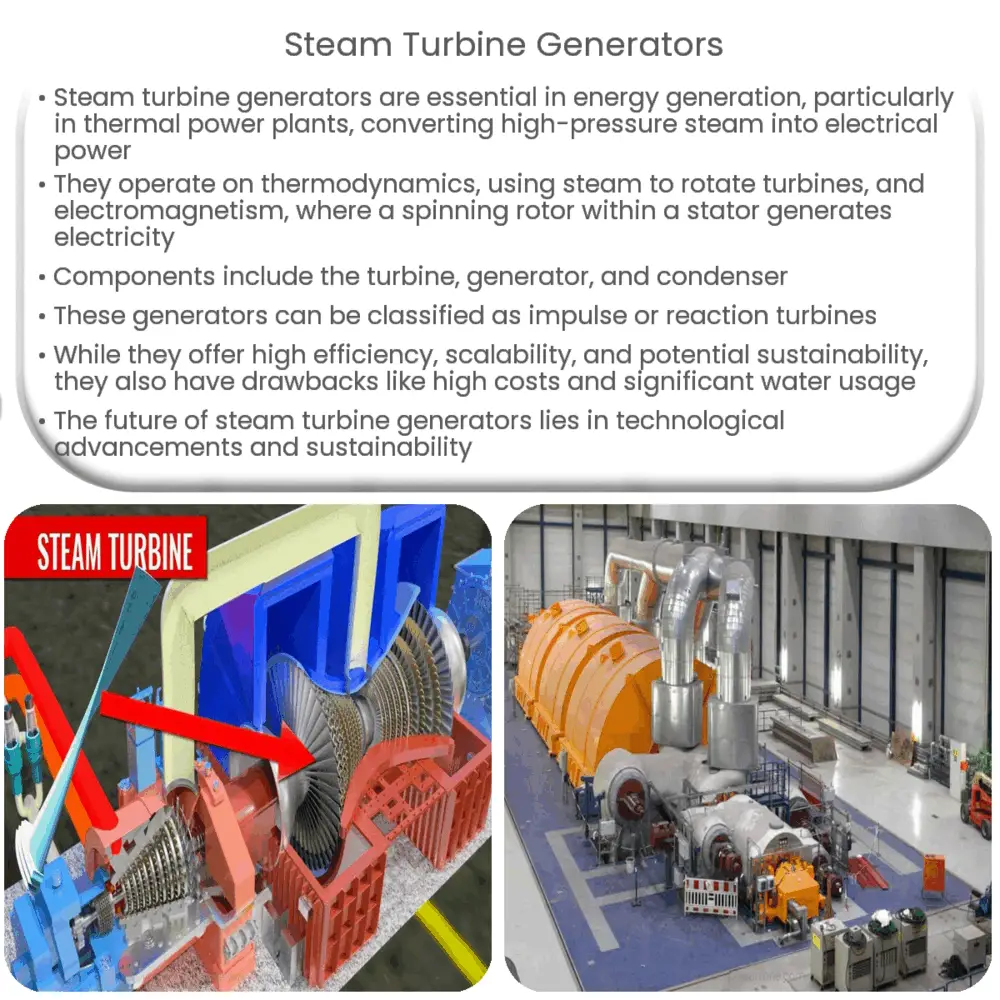Explore the workings of steam turbine generators, their components, types, advantages, disadvantages, and future trends in this comprehensive guide.

Introduction to Steam Turbine Generators
Steam turbine generators form a crucial part of the energy generation process, particularly in thermal power plants. Using high-pressure steam, they produce mechanical power which is then converted into electrical power, serving as an integral link in the power production chain.
Principles of Operation
At its most basic level, a steam turbine generator operates using the principles of thermodynamics and electromagnetism. It exploits the energy within steam to perform work, and the principles of electromagnetic induction to convert that mechanical work into electrical energy.
- Thermodynamics: The fundamental concept is that high-pressure, high-temperature steam is used to rotate the turbine. This rotation is the mechanical work that is converted into electrical energy.
- Electromagnetism: The rotor of the generator is attached to the steam turbine. As the steam causes the turbine to spin, the rotor also spins. This spinning rotor, within the stationary stator, creates a magnetic field that generates electricity.
Components of a Steam Turbine Generator
Steam turbine generators consist of several key components, all of which contribute to their functionality.
- Turbine: This is where the steam’s energy is initially converted into mechanical energy. It is comprised of a series of blades mounted on a shaft. The steam’s force against the blades spins the shaft.
- Generator: Attached to the turbine’s shaft, it converts the mechanical energy into electrical energy. Within the generator, the rotor spins inside the stator, leading to the generation of electricity.
- Condenser: Once the steam has passed through the turbine, it is cooled and converted back into water in the condenser. This water is then returned to the boiler for reuse, creating a cyclical process.
Types of Steam Turbine Generators
Steam turbine generators can be classified based on several factors. One such classification is based on the principle of operation:
- Impulse Turbines: In these turbines, high-pressure steam is ejected from a nozzle and hits the turbine blades, causing the rotor to spin.
- Reaction Turbines: Unlike impulse turbines, these utilize the principle of reaction. The steam expands within the turbine, and this expansion causes a force that spins the rotor.
Advantages and Disadvantages of Steam Turbine Generators
Like all technologies, steam turbine generators have their pros and cons. It’s vital to understand these when considering their implementation.
- Advantages:
- High Efficiency: Steam turbine generators can reach efficiencies of over 90%, making them extremely efficient at converting the energy in steam into electrical power.
- Scalability: Steam turbines can be designed and built to generate power ranging from just a few megawatts to hundreds of megawatts, making them suitable for a wide range of applications.
- Sustainability: When used in conjunction with renewable sources of heat, such as geothermal or solar thermal energy, steam turbines can generate electricity with minimal environmental impact.
- Disadvantages:
- Costly Installation and Maintenance: Initial setup and maintenance costs of steam turbine generators can be high, particularly for large-scale installations.
- Water Usage: The process of generating steam requires a substantial amount of water, which can be a limiting factor in arid regions.
Future of Steam Turbine Generators
With advancements in technology and a rising focus on sustainable energy sources, the role of steam turbine generators is expected to evolve. More efficient designs, better materials, and integration with renewable heat sources are areas of active research and development. In particular, the possibility of using supercritical and ultra-supercritical steam parameters promises higher efficiencies and lower emissions, pushing the boundaries of what these power generation workhorses can achieve.
Conclusion
In conclusion, steam turbine generators continue to play a vital role in global power generation. Their high efficiency, scalability, and potential for integration with renewable energy sources make them an attractive option for power generation. However, their high initial and maintenance costs, as well as their water requirements, pose challenges. The future of these generators lies in the advancement of technology and the continued pursuit of sustainable and efficient power generation methods. By understanding their workings, advantages, and disadvantages, we can continue to innovate and improve these essential tools of the power industry.

